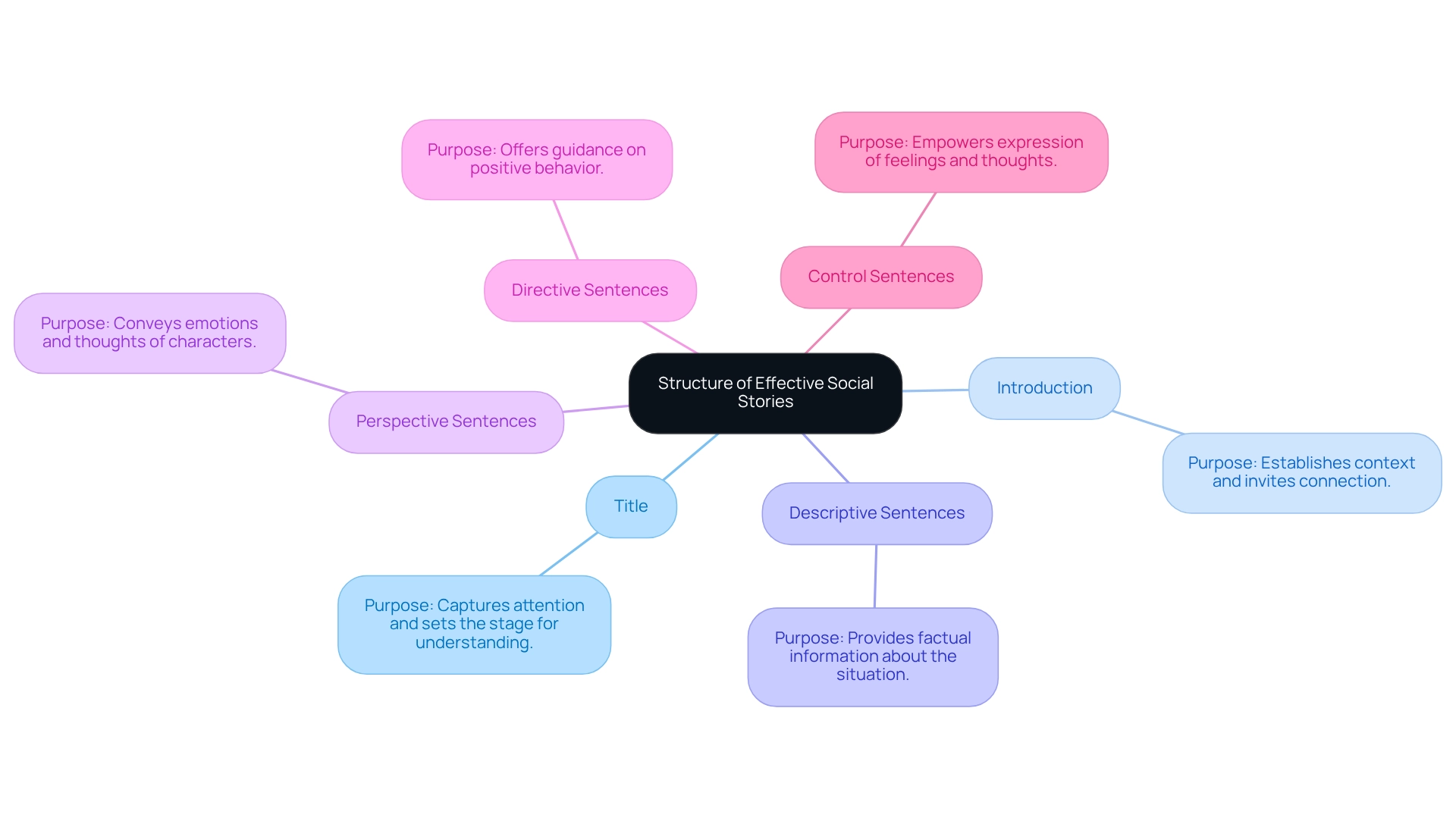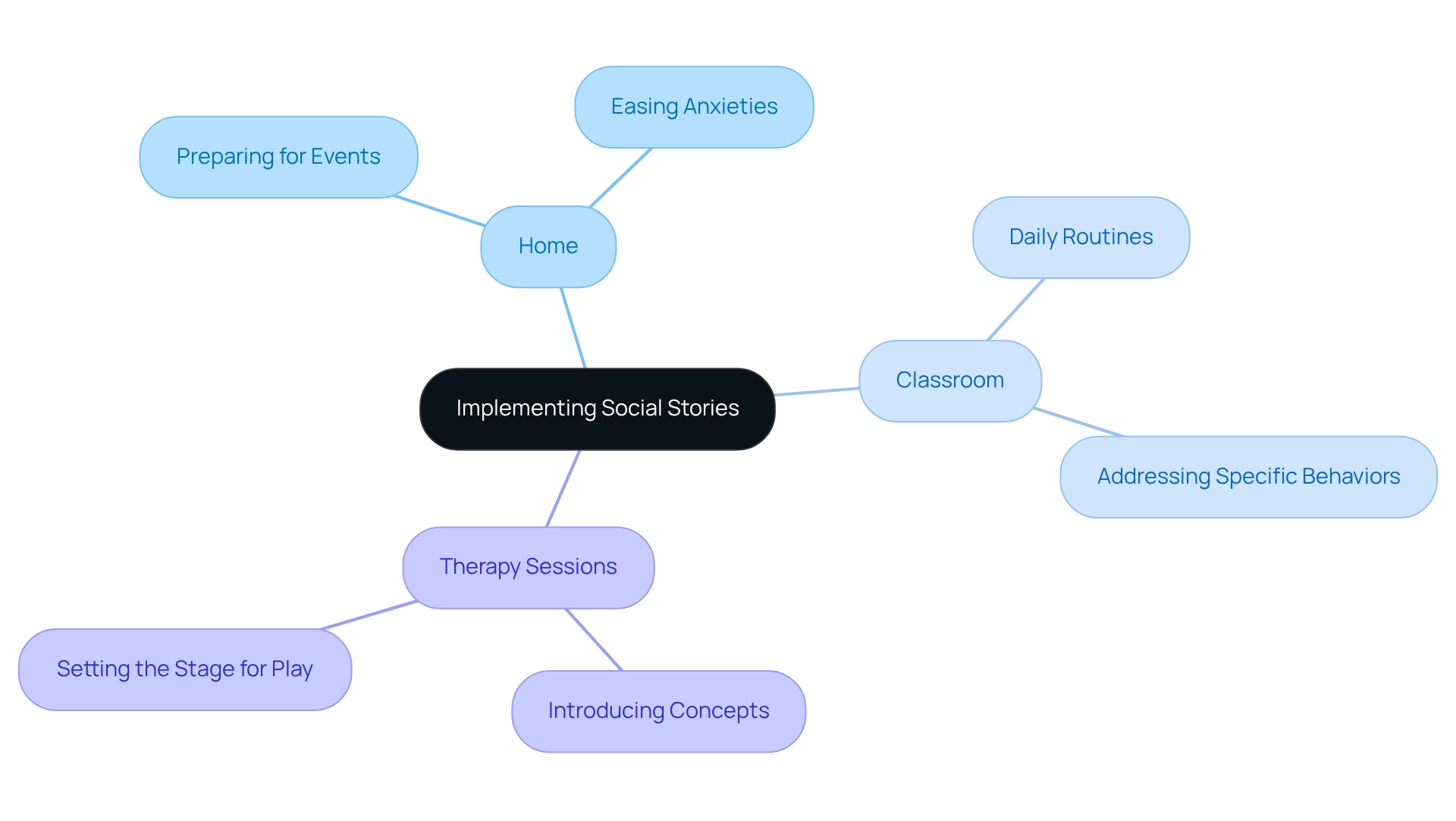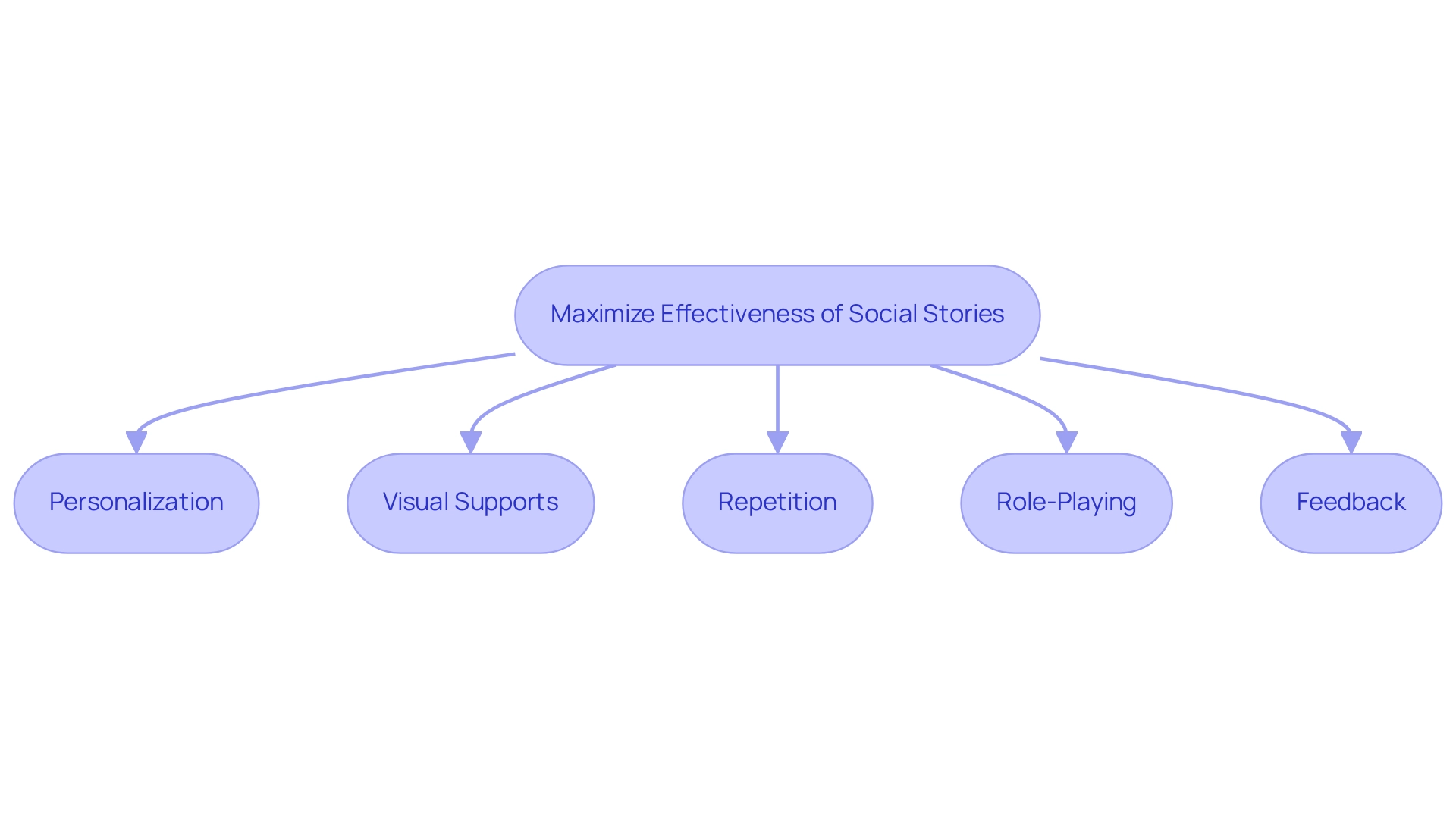Overview
This article highlights four effective ways to use social stories for behavior improvement, particularly for young individuals with autism. It draws attention to the significance of:
- Personalization
- Visual supports
- Repetition
- Role-playing
These elements are essential in crafting engaging narratives that not only help children comprehend social situations and expectations but also promote positive behavior and emotional regulation. By focusing on these strategies, we can nurture an environment where children feel understood and supported in their journey toward social awareness.
Introduction
In a world where social interactions can often feel overwhelming—especially for children with autism—social stories emerge as a powerful tool for nurturing understanding and building confidence. These concise narratives not only illustrate specific social situations but also outline appropriate behaviors, guiding children through the complexities of social cues and expectations. Developed by Carol Gray, social stories act as a bridge to ease anxiety and encourage positive interactions.
This article explores the essence of social stories, delving into their structure, implementation across various settings, and practical tips to maximize their effectiveness. Together, we can empower children to thrive in social environments, fostering a sense of belonging and acceptance.
Define Social Stories and Their Purpose
Brief narratives outline specific interpersonal scenarios and the suitable actions expected in those contexts. Created by Carol Gray, these narratives aim to assist young individuals, particularly those with autism, in understanding interpersonal signals and expectations. The primary goal of personal narratives is to provide clear, relatable illustrations that help young people navigate social interactions, thereby reducing anxiety and promoting positive social stories behavior.
By presenting interpersonal situations in a structured format, social stories behavior empower children to anticipate and respond to various scenarios effectively, nurturing their interpersonal skills and emotional regulation. For instance, a narrative about visiting the dentist can illustrate what to expect during the appointment, including the sounds of dental instruments and the importance of remaining still. This preparation not only alleviates fears but also encourages cooperation during the visit.
Such narratives serve as valuable tools for parents, offering insights and support to help their children thrive in social settings.

Outline the Structure of Effective Social Stories
Effective social stories behavior typically follows a structured format that includes several key components designed to support and nurture young readers.
- Title: A clear title that reflects the essence of the narrative, capturing attention and setting the stage for understanding.
- Introduction: A brief introduction that establishes the context for the story, inviting readers to connect with the content.
- Descriptive Sentences: These sentences provide factual information about the situation, including who is involved, where it takes place, and what happens, helping to create a vivid picture.
- Perspective Sentences: These convey the emotions and thoughts of the characters involved, assisting young readers in grasping different viewpoints and fostering empathy.
- Directive Sentences: These sentences offer guidance on what the young one should do in the situation, promoting positive behavior and encouraging thoughtful responses.
- Control Sentences: Optional sentences that empower the young person to express their feelings or thoughts about the situation, reinforcing their voice and emotions.
For instance, a narrative about sharing toys might include descriptive sentences about the toys, perspective sentences highlighting how friends feel when they share, and directive sentences encouraging the child to take turns. This organized approach ensures that the narrative is thorough and easy to comprehend, making it a valuable resource for personal growth and the development of social stories behavior. By utilizing these components, parents can create engaging and supportive stories that resonate with their children, fostering a deeper understanding of social situations.

Implement Social Stories Across Different Settings
Narratives can be a powerful tool in various settings, helping to foster constructive behaviors and enhance interpersonal skills. Imagine the comfort a simple story can bring to a child facing new experiences. Here are some effective strategies for using social stories in different environments:
-
Home: Family time can be enriched by reading narratives together. Parents might choose stories that prepare children for upcoming events, like a visit from relatives or the start of a new school year. This approach not only helps children grasp what to expect but also eases their anxieties.
-
Classroom: Teachers can weave narrative techniques into their daily routines. For example, addressing specific behaviors—like lining up or engaging in group activities—can be made easier by utilizing social stories behavior and reading a relevant story beforehand. This practice can help students feel more at ease as they transition into the activity.
-
Therapy Sessions: In therapy, ABA therapists can introduce new concepts or skills through narratives. Consider using social stories behavior to illustrate taking turns, which can set the stage for collaborative play before a game, making the experience more relatable and less intimidating for children.
By consistently integrating narrative techniques across these environments, children can internalize valuable lessons and apply them in real-life situations. This not only enhances their interpersonal understanding but also supports their overall development. Let’s embrace the power of stories together—after all, every narrative shared is a step towards nurturing understanding and connection.

Maximize Effectiveness with Practical Tips
To maximize the effectiveness of social stories, consider these practical tips that can truly make a difference:
- Personalization: Customize the social narrative to reflect the young person's interests and experiences. By incorporating familiar characters or scenarios, you make the narrative more relatable and engaging for them.
- Visual Supports: Enhance understanding by incorporating visuals, such as pictures or drawings. Visual aids can help youngsters grasp concepts more easily and remember information more effectively.
- Repetition: Read the social narrative multiple times to reinforce the message. Regular exposure assists young ones in assimilating the actions and expectations described in the narrative.
- Role-Playing: After reviewing the narrative, engage in role-playing scenarios to practice the behaviors in a safe environment. This hands-on approach not only reinforces learning but also builds confidence.
- Feedback: Encourage young ones to share their thoughts and feelings about the narrative. This feedback can provide valuable insights into their comprehension and help tailor future narratives to better meet their needs.
By implementing these tips, parents and professionals can enhance the impact of social stories behavior, leading to improved behavior and social skills in children. Remember, every small step you take can lead to significant changes in their social development.

Conclusion
Social stories are a vital resource for children, especially those with autism, as they simplify complex social situations into manageable narratives. By outlining specific behaviors and expectations, these stories help alleviate anxiety and foster positive interactions. The structured format of social stories—comprising titles, descriptive, perspective, directive, and control sentences—ensures clarity and relatability, enabling children to better understand the social cues around them.
Implementing social stories across various environments, such as home, school, and therapy sessions, reinforces the lessons learned and promotes consistent behavior. Their adaptability makes social stories suitable for diverse situations, allowing children to internalize social norms and expectations effectively.
To maximize their impact, the following practices are essential:
- Personalization
- Visual supports
- Repetition
- Role-playing
- Feedback
These strategies not only enhance comprehension but also empower children to engage confidently in social interactions. Ultimately, social stories are more than just narratives; they are powerful tools that cultivate understanding, acceptance, and a sense of belonging in social contexts. By embracing their use, caregivers and educators can significantly contribute to the social development and emotional well-being of children. Together, let’s support our children in navigating their social worlds with confidence and understanding.
Frequently Asked Questions
What are personal narratives in the context of social stories?
Personal narratives are brief stories that outline specific interpersonal scenarios and the suitable actions expected in those contexts, created to assist young individuals, particularly those with autism, in understanding interpersonal signals and expectations.
What is the primary goal of personal narratives?
The primary goal of personal narratives is to provide clear, relatable illustrations that help young people navigate social interactions, thereby reducing anxiety and promoting positive social behavior.
How do social stories empower children?
Social stories empower children by presenting interpersonal situations in a structured format, enabling them to anticipate and respond effectively to various scenarios, which nurtures their interpersonal skills and emotional regulation.
Can you give an example of a social story?
An example of a social story is a narrative about visiting the dentist, which illustrates what to expect during the appointment, including the sounds of dental instruments and the importance of remaining still to alleviate fears and encourage cooperation.
How do personal narratives benefit parents?
Personal narratives serve as valuable tools for parents by offering insights and support to help their children thrive in social settings.




